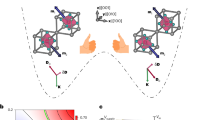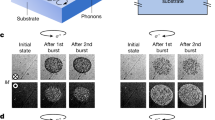Abstract
Research in semiconductor spintronics aims to extend the scope of conventional electronics by using the spin degree of freedom of an electron in addition to its charge1. Significant scientific advances in this area have been reported, such as the development of diluted ferromagnetic semiconductors2,3, spin injection into semiconductors from ferromagnetic metals4,5,6,7,8 and discoveries of new physical phenomena involving electron spin9,10. Yet no viable means of developing spintronics in semiconductors has been presented. Here we report a theoretical design that is a conceptual step forward—spin accumulation is used as the basis of a semiconductor computer circuit. Although the giant magnetoresistance effect in metals11,12 has already been commercially exploited, it does not extend to semiconductor/ferromagnet systems, because the effect is too weak for logic operations. We overcome this obstacle by using spin accumulation rather than spin flow13,14,15. The basic element in our design is a logic gate that consists of a semiconductor structure with multiple magnetic contacts; this serves to perform fast and reprogrammable logic operations in a noisy, room-temperature environment. We then introduce a method to interconnect a large number of these gates to form a ‘spin computer’. As the shrinking of conventional complementary metal-oxide–semiconductor (CMOS) transistors reaches its intrinsic limit, greater computational capability will mean an increase in both circuit area and power dissipation. Our spin-based approach may provide wide margins for further scaling and also greater computational capability per gate.
This is a preview of subscription content, access via your institution
Access options
Subscribe to this journal
Receive 51 print issues and online access
$199.00 per year
only $3.90 per issue
Buy this article
- Purchase on Springer Link
- Instant access to full article PDF
Prices may be subject to local taxes which are calculated during checkout



Similar content being viewed by others
References
Wolf, S. A. et al. Spintronics: A spin based electronics vision for the future. Science 294, 1488–1495 (2001)
Ohno, Y. et al. Electrical spin injection in a ferromagnetic semiconductor heterostructure. Nature 402, 790–792 (1999)
Dietl, T., Ohno, H., Matsukura, F., Cibert, J. & Ferrand, D. Zener model description of ferromagnetism in zinc-blende magnetic semiconductors. Science 287, 1019–1022 (2000)
Zhu, H. J. et al. Room-temperature spin injection from Fe into GaAs. Phys. Rev. Lett. 87, 016601 (2001)
Hanbicki, A. T. et al. Analysis of the transport process providing spin injection through a Fe/AlGaAs Schottky barrier. Appl. Phys. Lett. 82, 4092–4094 (2003)
Jiang, X. et al. Highly spin-polarized room-temperature tunnel injector for semiconductor spintronics using MgO(100). Phys. Rev. Lett. 94, 056601 (2005)
Crooker, S. A. et al. Imaging spin transport in lateral ferromagnet/semiconductor structures. Science 309, 2191–2195 (2005)
Lou, X. et al. Electrical detection of spin transport in lateral ferromagnet–semiconductor devices. Nature Phys. 3, 197–202 (2007)
Kato, Y. K., Myers, R. C., Gossard, A. C. & Awschalom, D. D. Observation of the spin Hall effect in semiconductors. Science 306, 1910–1913 (2004)
Wunderlich, J., Kaestner, B., Sinova, J. & Jungwirth, T. Experimental observation of the spin-Hall effect in a two-dimensional spin-orbit coupled semiconductor system. Phys. Rev. Lett. 94, 047204 (2005)
Baibich, M. N. et al. Giant magnetoresistance of (001)Fe/(001)Cr magnetic superlattices. Phys. Rev. Lett. 61, 2472–2475 (1988)
Binasch, G., Grünberg, P., Saurenbach, F. & Zinn, W. Enhanced magnetoresistance in layered magnetic structures with antiferromagnetic interlayer exchange. Phys. Rev. B 39, R4828–R4830 (1989)
Johnson, M. Bipolar spin switch. Science 260, 320–323 (1993)
Jedema, F. J., Filip, A. T. & van Wees, B. J. Electrical spin injection and accumulation at room temperature in an all-metal mesoscopic spin valve. Nature 410, 345–348 (2001)
Stephens, J. et al. Spin accumulation in forward-bias MnAs/GaAs Schottky diodes. Phys. Rev. Lett. 93, 097602 (2004)
Johnson, M. in Magnetoelectronics (ed. Johnson, M.) 273–330 (Elsevier, San Diego, 2004)
Cowburn, R. P. & Welland, M. E. Room temperature magnetic quantum cellular automata. Science 287, 1466–1468 (2000)
Hanbicki, A. T. et al. Nonvolatile reprogrammable logic elements using hybrid resonant tunneling diode–giant magnetoresistance circuits. Appl. Phys. Lett. 79, 1190–1192 (2001)
Richter, R., Bär, L., Wecker, J. & Reiss, G. Non-volatile field programmable spin-logic for reconfigurable computing. Appl. Phys. Lett. 80, 1291–1293 (2002)
Ney, A., Pampuch, C., Koch, R. & Ploog, K. H. Programmable computing with a single magnetoresistive element. Nature 425, 485–487 (2003)
Imre, A. et al. Majority logic gate for magnetic quantum-dot cellular automata. Science 311, 205–208 (2006)
Datta, S. & Das, B. Electronic analogue of the electro-optic modulator. Appl. Phys. Lett. 56, 665–667 (1990)
Kikkawa, J. M. & Awschalom, D. D. Resonant spin amplification in n-type GaAs. Phys. Rev. Lett. 80, 4313–4316 (1998)
Tehrani, S. et al. Recent developments in magnetic tunnel junction MRAM. IEEE Trans. Magn. 36, 2752–2757 (2000)
Gerrits, van den Berg, H. A. M., Hohlfeld, J., Bär, L. & Rasing Ultrafast precessional magnetization reversal by picosecond magnetic field pulse shaping. Nature 418, 509–512 (2002)
Dery, H., Cywiński, Ł. & Sham, L. J. Spin transference and magnetoresistance amplification in a transistor. Phys. Rev. B 73, 161307(R) (2006)
Hauck, S. The roles of FPGAs in reprogrammable systems. Proc. IEEE 86, 615–639 (1998)
Skumryev, V. et al. Beating the superparamagnetic limit with exchange. Nature 423, 850–853 (2003)
Dery, H. & Sham, L. J. Spin extraction theory and its relevance to spintronics. Phys. Rev. Lett. 98, 046602 (2007)
Pikus, G. E. & Titkov, A. N. in Optical Orientation Vol. 8 (eds Meier, F. & Zakharchenya, B. P.) 73–131 (North-Holland, New York, 1984)
Acknowledgements
We thank B. Dalal for suggestions regarding the logic cascading scheme. This work was supported by the National Science Foundation.
Author Contributions H.D. and L.J.S. developed the proposed idea of spin computation. P.D. designed the cascading scheme. Ł.C. formulated the time-dependent spin-diffusion transport.
Author information
Authors and Affiliations
Corresponding author
Ethics declarations
Competing interests
Reprints and permissions information is available at www.nature.com/reprints. The authors declare no competing financial interests.
Supplementary information
Supplementary Information
The first section ‘Magnetologic gates for high speed electronics’ contains the discussion of the ways in which the signal-to-noise can be improved, and it discusses the different capacitive parasitic effects present in the system. The second section ‘Thyristor latch’ contains a description of the thyristor latch which we use to convert the transient current into a voltage. The third section ‘Power budgeting’ contains the calculation of the power dissipated by a system of ~106 magnetologic gates. The fourth section ‘Magnetization errant dynamics: data retention, write fault and half selection’ qualitatively explains how the possible sources of errors in magnetic random access memories (due to magnetization switching) are eliminated in our spin-logic design. The fifth section contains Supplementary Methods with a detailed account of the time-dependent lateral diffusion equations which we have used in our calculations (figure 2 of the main text). (PDF 560 kb)
Rights and permissions
About this article
Cite this article
Dery, H., Dalal, P., Cywiński, Ł. et al. Spin-based logic in semiconductors for reconfigurable large-scale circuits. Nature 447, 573–576 (2007). https://doi.org/10.1038/nature05833
Received:
Accepted:
Issue Date:
DOI: https://doi.org/10.1038/nature05833
This article is cited by
-
Regulation of quantum spin conversions in a single molecular radical
Nature Nanotechnology (2024)
-
A reprogrammable mechanical metamaterial with origami functional-group transformation and ring reconfiguration
Nature Communications (2023)
-
Tunable spin injection and detection across a van der Waals interface
Nature Materials (2022)
-
Giant converse magnetoelectric effect in a multiferroic heterostructure with polycrystalline Co2FeSi
NPG Asia Materials (2022)
-
Recent progress on optomagnetic coupling and optical manipulation based on cavity-optomagnonics
Frontiers of Physics (2022)
Comments
By submitting a comment you agree to abide by our Terms and Community Guidelines. If you find something abusive or that does not comply with our terms or guidelines please flag it as inappropriate.



